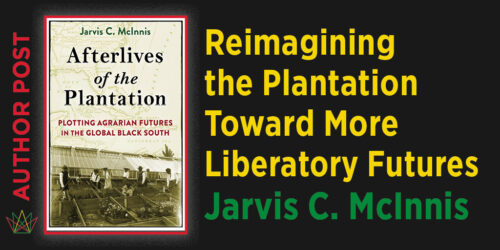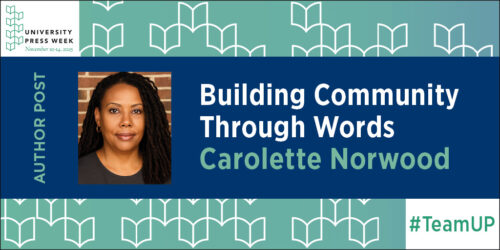Laura E. Helton on Scattered and Fugitive Things

In Scattered and Fugitive Things, Laura E. Helton tells the stories of six Black collectors who played a pivotal role in shaping the early twentieth-century Black archive. From the parlors of the urban North to HBCU reading rooms and branch libraries in the Jim Crow South, these collectors undertook a challenging task: to preserve and celebrate Black history and culture at a time when both were often dismissed or suppressed. In this Q&A, Helton sheds light on the gendered politics of Black archiving, revealing the central role of material practices like collecting, curation, and cataloging in Black intellectual history.
Q: What does the title, Scattered and Fugitive Things, refer to?
Laura E. Helton: The title comes from a 1930 article about the remarkable collection of L. S. Alexander Gumby, written by the journalist Aubrey Bowser for the New York Amsterdam News. Known for his elaborate scrapbooks on Negro History and for the exuberant art salons he hosted in his Harlem studio, Gumby is one of the six collectors that I chronicle in the book. Arguing for the importance of documenting Black history and culture, Bowser praised Gumby for saving “many scattered and fugitive things that cannot be found without a systematic and concentrated search.” I borrowed that phrase for the title of the book because it captures two truths about what it took to build Black archives in the early twentieth century.
At a moment when popular culture and scholarly accounts often dismissed the very idea of Black history, Black thinkers had to go to great lengths to assemble an archive. They had to identify what materials existed, appraise those scattered objects, and find a way to acquire them. The bibliophile Arturo (“Arthur”) Schomburg, for example, spent twelve years searching for a single picture of Benjamin Banneker. The only known portrait of Banneker appeared in a scarce edition of the eighteenth-century almanacs he authored, and Schomburg would not rest until locating a copy. Like Schomburg, the collectors in Scattered and Fugitive Things dedicated their lives to finding the abundant but scattered evidence of Black life and history and giving it shelter—whether in the parlor libraries kept by Schomburg and Gumby or in public collections like the one Dorothy Porter organized at Howard University.
Sometimes their pursuit of these records required fugitivity. Challenging laws and customs that treated Black knowledge as dangerous or forbidden, collectors had to fight for the right of their collections to exist—and for their ability to make these materials available to readers. Paradoxically, their commitment to render Black history usable might entail secrecy or stealth. In Roanoke, for example, Virginia Lee had to hide books on Black history in the public library’s basement when white city officials threatened to dismantle the collection. At Howard, Porter had to defy prevailing information systems just to catalog Black books. Black archiving thus drew on strategies familiar across Black freedom struggles: fugitivity, dissemblance, and the underground.
Q: Who is the woman on the cover? She looks glamorous.
Helton: The cover art is by Winold Reiss, a German-born illustrator who created a series of portraits in 1925 for “Harlem: Mecca of the New Negro,” a special issue of Survey Graphic magazine that was later transformed into the most famous Harlem Renaissance anthology, The New Negro, edited by Alain Locke. This particular portrait is titled The Librarian, and it comes from a set called “Four Portraits of Negro Women.” The drawing was published in black and white—as you see on the cover of Scattered and Fugitive Things—but the original, held by Fisk University Galleries, depicts “The Librarian” wearing a vibrant yellow top under a voluminous, fringed jacket. With her book in hand, hat cocked jauntily over one eye, and a knowing expression, she exudes confidence and sophistication, taking her place alongside the other portraits of Black modernity that peopled The New Negro.
By choosing this image for the cover, I wanted to underscore the presence of Black librarians at the center of social and intellectual life. In an essay that appeared alongside Reiss’s portraits, Elise Johnson McDougald described the emerging cohort of Black women in the 1920s doing “trained library work,” whose vision was “illuminated by fires that have somewhat of a missionary glow.” While they faced obstacles to advancement within academic circles, their professional training placed them at the helm of “New Negro Libraries” taking shape on HBCU campuses, in Southern towns, and in receiving cities of the Great Migration.
As Ethelene Whitmire writes in her biography of the librarian Regina Anderson, Reiss personally knew many of Harlem’s librarians. Famous for the literary salons she cohosted with the activist Ethel Ray Nance, Anderson’s apartment was one of the places where early conversations about The New Negro unfolded. Reiss joined some of those meetings, and The Librarian is probably a composite portrait of the Black librarians he met during the early 1920s.
With this illustration, I pay tribute not only to the three women featured in Scattered and Fugitive Things—public librarians Virginia Lee and Vivian Harsh and Howard University curator Dorothy Porter—but also to the broader group of women they represent. One of the storylines my book traces is a shift, starting in the 1920s, when the locus of Black collecting began to move from the homes of bibliophiles—men like Schomburg, Henry Slaughter, or Jesse Moorland—to the public reading rooms of branch libraries and universities. When that shift occurred, collections passed from a largely male world of bookworms to the care of Black women librarians. Tasked with making Black libraries and archives accessible to the public, these women became system builders. They created tools for enumerating and accessing Black print, and their role in creating Black intellectual worlds deserves more critical attention.
Q: You chronicle six collectors in this book. Are they connected to each other, or are these six separate stories?
Helton: Each of the six collectors featured in Scattered and Fugitive Things represents a different trajectory for African American and African diasporic thinkers in the early twentieth century. Schomburg, who was largely self-taught, grew up in Puerto Rico and the Virgin Islands before embarking for New York City in the 1890s. Gumby, born in Maryland, became a working-class denizen of Harlem’s queer underground after the turn of the twentieth century. Virginia Lee, part of the first class of librarians trained at the Hampton Institute, spent her entire career working in the South both before and after desegregation. Dorothy Porter, raised in a world of Black elites in New Jersey, became a fixture of Howard University’s intellectual milieu. Vivian Harsh, whose parents survived enslavement and migrated north, built a library for the Great Migration’s new arrivals in Chicago. The historian L. D. Reddick, a Fisk graduate, served for a decade as curator of Schomburg’s collection before moving back to the South and becoming a resident documentarian of the civil rights movement.
So these are six distinct stories, each set in a different scene—from the Harlem apartment where Schomburg welcomed his bibliophile friends to “peep at the books” to a bustling branch library on Chicago’s South Side. Yet the stories are also entwined. Schomburg frequented Gumby’s salons, met Lee, and mentored Porter, who in turn corresponded with Harsh and Reddick. Beyond their personal connections, these six collectors enacted a shared set of commitments, which I describe as core principles of Black archiving. They all took risks, both material and intellectual, to provide access to Black ideas. As each chapter in the book shows, such risk-taking entailed a tension between fugitivity and visibility, as efforts to value and order Black materials—and to create spaces for their preservation and study—necessarily involved defiance in the face of opposition.
Q: What did they collect? And how did their collections reshape history?
Helton: The collections built by early twentieth-century Black bibliophiles and librarians were far-reaching and heterogeneous. They collected nineteenth-century abolitionist pamphlets, theatrical playbills, proceedings of the colored conventions, first editions of Black poets, religious texts, manuscript sermons, dictionaries of African languages, letters penned by Black soldiers, and more. Where others had seen absence, they created abundance.
It’s important to remember that Black collectors undertook this work at a moment when there were no other publicly accessible research collections devoted to Black life or history. Prevailing information systems left Black subjects out of reference tools, and the antiquarian market deemed most Black print culture of little worth. As a result, these collectors had to invent the very idea of a Black archive. As part of that work, they experimented with the question of what belonged in their collections. Should they collect rare books or ordinary ephemera? Records of achievement or of struggle? Of renegades or reformers? Of the nation-state or the diaspora? Their answers to these questions—what they chose to collect and what they eschewed—would profoundly shape the archival spaces of Black memory for generations to come.
Q: You say that your book illuminates the gendered politics of Black archiving. How so?
Helton: Scattered and Fugitive Things illuminates material practices of recordkeeping: collecting, curation, and cataloging. I argue that such practices are central to Black intellectual history, though we often overlook them. Examples abound. W. E. B. Du Bois was a bibliographer; Alain Locke composed reading lists for the American Library Association; Nella Larsen, Arna Bontemps, and Anne Spencer were librarians; Robert Hayden inventoried manuscripts. Better known for their poetry or prose, all of these figures also devoted significant energy to creating infrastructures for reading. In a segregated information landscape, Black thinkers understood the urgency of building and maintaining knowledge structures for Black ideas.
To study these practices requires looking at the seemingly perfunctory documents and objects collectors left behind: book lists, card catalogs, classification systems, accession numbers, and acquisition records. Such records belong to what Antoinette Burton calls the “backstage of archives,” and they seem to resist interpretation. Our own digital era has largely cast aside such objects. Mimeographed bibliographies, vertical files, subheadings in a card file: all have receded from everyday use, though they once were essential conduits to otherwise fugitive traces of Black knowledge. Recapturing the urgency of these overlooked sources offers new insights into African American literary and cultural history, including the centrality of women—many of them woefully understudied—who created information systems and public spaces for Black thought. As I further argue in the book, the gendered framework of intellectual history often eclipses not just women thinkers, but also certain types of labor—such as creating clipping files or managing libraries—associated with women’s domestic work, even when undertaken by men and women alike. Bringing such practices back into view and centering them in the study of Black ideas promises to expand not only the intellectual pantheon but also the very notion of what we mean by intellectual history.








